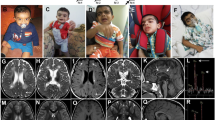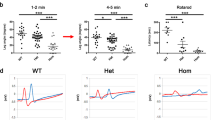Summary
We describe a number of biochemical and pathological findings in a neurological syndrome which resulted from a mutation in the congenic resistant strain, B10.C(47N). The mutation, designated with the symbol msd, is sex-linked, recessive, and causes tremor, repeated seizures, and death of affected males at about 18–23 days of postnatal age. The earliest detectable clinical signs appear around 10 days of age. The CNS is markedly deficient in myelin. The white matter fiber tracts appear essentially as “negative images”. In contrast, the peripheral nerves are myelinated.
Among quantitative differences in lipid composition of the CNS between normal and mutant mice, major deficiencies involve cholesterol and galactolipids, i.e., cerebrosides and sulfatides, but not gangliosides. Quantitative and qualitative abnormalities of cerebrosides, sulfatides, and sphingomyelin are detectable chromatographically. Both cerebroside spots are lacking, sulfatides are either absent or greatly diminished, and only the lower sphingomyelin band is present. A major difference between mutant and control brains involves the ratio of total saturated to unsaturated fatty acids which is significantly higher in mutant than control mice, an indication that the mutant brain is less able to retain unsaturates. The situation with respect to dimethylacetals of plasmalogens has not yet been resolved.
Although msd is similar to jp (jimpy) genetically and biochemically, tests for allelism and linkage to determine the position of the two genes relative to one another are still inconclusive. Therefore, it appears at present more likely that the two genes are different and non-allelic.
Similar content being viewed by others
References
Baumann, N.A., Jacquie, C.M., Pallet, S.A., Harpin, M.L.: Patty acid and lipid composition of the brain of a myelin deficient mutant the “quaking” mouse. European J. Biochem. 4, 340–344 (1968).
Benton, J.W., Moser, H.W., Dodge, P.R., Carr, S.: Modification of the schedule of myelination in the rat by early nutritional deprivation. Pediatrics 38, 801–807 (1966).
Fiske, C.H., Subbarow, R.R.: The colorimetric determination of phosphorus. J. biol. Chem. 66, 376–400 (1925).
Folch-Pi, J.: In: Biochemistry of Developing Nervous System, pp. 121–136. Ed. by H. Waelsch. New York: Academic Press 1955.
—, Lees, M., Sloane-Stanley, G.H.: A simple method for the isolation and purification of total lipides from animal tissues. J. biol. Chem. 226, 491–509 (1957).
Kandutsch, A.A., Saucier, S.E.: Regulation of sterol synthesis in developing brains of normal and jimpy mice. Arch. Biochem. Biophys. (in press).
Kean, E.L.: Rapid, sensitive spectrophotometric method for quantitative determination of sulfatides. J. Lipid Res. 9, 319–327 (1968).
Kostic, D., Nussbaum, J.L., Nescovik, N.: Gangliosides in brain of two mutant mice, “quaking” and “jimpy”. Abstr. 2nd Meeting, Internat. Soc. Neurochem. (Milan), p. 254 (1969).
Kurihara, T., Nussbaum, J.L., Mandel, P.: 2′,3′-cyclic nucleotide 3′-phosphohydrolase in the brain of jimpy mice, a mutant with deficient myelination. Brain Res. 13, 401–403 (1969a).
- - Kostic, D., Mandel, P.: 2′,3′-cyclic nucleotide 3′-phosphohydrolase: a new marker of myelin. Abstr. 2nd Meeting, Internat. Soc. Neurochem. (Milan), p. 254 (1969).
Lapetina, E.G., Sato, E.F., DeRobertis, E.: Gangliosides and acetylcholinesterase in isolated membranes of the rat-brain cortex. Biochim. biophys. Acta (Amst.) 135, 33–34 (1967).
Lauter, C.J., Trams, E.G.: A spectrophotometric determination of sphingosine. J. Lipid Res. 3, 136–138 (1962).
Meier, H.: The neuropathology of ducky, a neurological mutation of the mouse. Acta Neuropath. (Berl.) 11, 15–28 (1968).
- Dickie, M.M.: A neurological mutation of the mouse with a deficiency of myelin synthesis. Abstr. 2nd Meeting, Internat. Soc. Neurochem. (Milan), p. 287 (1969).
Nussbaum, J.L., Neskovic, N., Mandel, P.: A study of lipid components in brain of the “jimpy” mouse, a mutant with myelin deficiency. J. Neurochem. 16, 927–934 (1969).
O'Brien, J.S.: Stability of the myelin membrane. Science 147, 1099–1107 (1965).
—, Fillerup, D.L., Mead, J.F.: Brain lipids. I. Quantification and fatty acid composition of cerebroside sulfate in human cerebral gray and white matter. J. Lipid Res. 5, 109–116 (1964a).
—: Quantification and fatty aldehyde composition of ethanolamine, choline, and serine glycerophosphatides in human cerebral gray and white matter. J. Lipid Res. 5, 329–338 (1964b).
—, Rouser, G.: The fatty acid composition of brain sphingolipids: sphingomyelin, ceramide, cerebroside, and cerebroside sulfate. J. Lipid Res. 5, 339–342 (1964).
—, Sampson, E.L.: Fatty acid and fatty aldehyde composition of the major brain lipids in normal human gray matter, white matter, and myelin. J. Lipid Res. 6, 545–551 (1965).
Rouser, G., Galli, C., Lieber, E., Blank, M.L., Pivett, O.S.: Analytical fractionation of complex lipid mixtures: DEAE cellulose cloumn chromatography combined with quantitative thin-layer chromatography. J. Amer. Oil Chem. Soc. 41, 836–840 (1964).
Sidman, R.L., Dickie, M.M., Appel, S.H.: Mutant mice (quaking and jimpy) with deficient myelination in the central nervous system. Science 144, 309–311 (1964).
- Green, M.C., Appel, S.H.: Catalogue of the Neurological Mutants of the Mouse. Harvard U. Press 1965.
Sorenson, M., Haugaard, G.: Über die Anwendbarkeit der Orcinreaktion zur Bestimmung der Art und Menge von Kohlenhydratgruppen in Eiweißstoffen. Biochem. Z. 260, 247–277 (1933).
Staats, J.: A revision of the standardized genetic nomenclature for mice. J. Hered. 54, 159–162 (1963).
Uzman, L.L., Rumley, M.K.: Changes in the composition of the developing mouse brain during early myelination. J. Neurochem. 3, 171–184 (1958).
Warren, L.: The thiobarbituric acid assay of sialic acids. J. biol. Chem. 234, 1971–1975 (1959).
Zak, B.: Simple rapid microtechnic for serum total cholesterol. Amer. J. clin. Path. 27, 583–588 (1957).
Author information
Authors and Affiliations
Additional information
The deviant mouse was discovered by Mrs. Helen P. Bunker in the mouse colonies of Dr. George D. Snell. The mutation is maintained in the laboratory of the late Dr. Margaret M. Dickie. This article is dedicated to Dr. Dickie in professional gratitude.
This investigation was supported in part by Public Health Service research grant NB 06448 from the National Institute of Neurological Diseases and Stroke, a grant from the National Foundation for Neuromuscular Diseases, Inc., a grant from the United Medical Research Foundation of North Carolina, and a grant from the Southwaite Foundation.
The principles of laboratory animal care as promulgated by the National Society for Medical Research are observed in this Laboratory.
Rights and permissions
About this article
Cite this article
Meier, H., MacPike, A.D. A neurological mutation (msd) of the mouse causing a deficiency of myelin synthesis. Exp Brain Res 10, 512–525 (1970). https://doi.org/10.1007/BF00234267
Received:
Issue Date:
DOI: https://doi.org/10.1007/BF00234267




